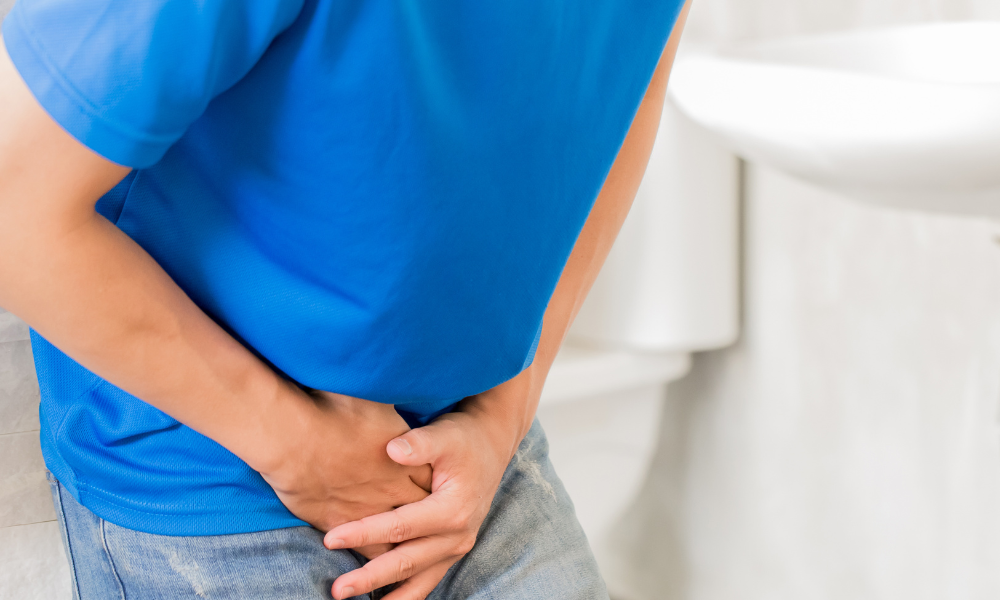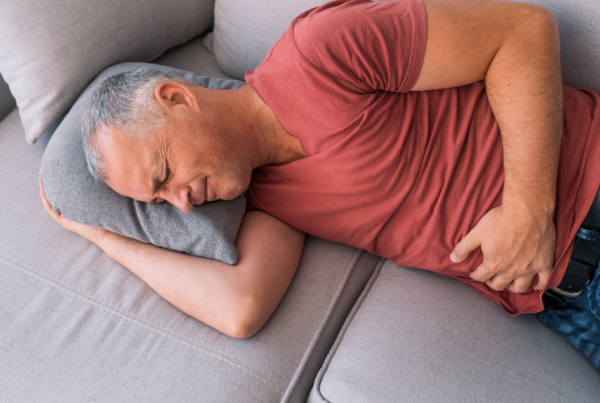Dysuria
Move Better. Live Fuller. Your Wellness Journey Starts Here.
Schedule a FREE Discovery Call!
What Is Dysuria?
Dysuria is a term that refers to symptoms of pain or discomfort with urination. It can be felt as a sharp pain, a burning sensation, itching, or aching in the pelvic area—and can be created by many different causes. It can happen to any person regardless of sex, but is more common in those with a vagina.
The timing of the pain can vary. It may be felt at the start of urination, following urination, or both.
The pain may also be present in other areas of the body, such as the bladder, lower back, lower abdomen, and pelvis. For some, the pain can be felt in the penis, and for those with a vagina, the pain can be felt internally or at the urethral opening.

What Causes Painful Urination?
Pain with urination can be caused by many different factors that vary from person to person. In many cases, painful urination (especially for those who have a vagina) is often attributed to UTIs. However, UTIs are not always the cause.
For many individuals, pelvic floor dysfunction or pelvic floor tension can cause painful urination, and even mimic the symptoms of a UTI, STI, yeast infection, and other conditions. And yet, pelvic floor dysfunction isn’t something many people consider when they experience dysuria.
If you test for any of those conditions—such as a UTI, for example—and have a negative test, or if you still have persistent symptoms after your UTI is supposedly gone, you’ll definitely want to check in with a pelvic floor physical therapist. But, how exactly does pelvic floor tension cause painful urination?
When your pelvic muscles are tight, your urethra becomes tighter, too—this can happen regardless of what genitals you have. It is as if you are trying to urinate through a very tight tube. This can cause difficulty with emptying your bladder, and may make you feel as though you need to urinate more often. Additionally, this can actually increase your chances of having a UTI, as the urine can become stuck in the urethra due to it being narrowed.
This muscle tightness isn’t limited to just the pelvic floor. It can occur anywhere in or near the pelvic floor region, affecting the pelvis, hips, lower abdominal muscles, and more. Imbalance in these areas can create pain that feels closer to the bladder itself.
In addition to UTIs or pelvic floor tightness, your painful urination could be attributed to the following:
- Bladder / vaginal infection
- Bladder or kidney stones
- Urethritis
- Endometritis
- Bladder / urethral inflammation
- Prostatitis
- STIs
- Interstitial cystitis
- Menopause
- Sensitivity from products
- Side effects from medications
- Chronic pelvic pain syndrome
- Nerve entrapment
- Scar tissue / adhesions
- And many other conditions or infections
Physical Therapy for Painful Urination
Painful urination is something that can be attributed to many different causes, but in many cases, pelvic floor physical therapy can be a very beneficial treatment and preventative health strategy. The pelvic floor encapsulates all the organs and muscles surrounding your bladder, urethra, and urethral opening. Therefore, it is usually involved either directly or indirectly with the cause of your dysuria.
As mentioned before, having tight pelvic floor muscles will constrict your urethra, making it difficult to urinate effectively. But that isn’t the only symptom of tight pelvic floor muscles. In many of the causes mentioned above (interstitial cystitis, menopause, UTIs, and more) the pelvic floor plays an important role.
In other words, maintaining good health and flexibility of the pelvic floor muscles is an effective way of preventing and treating symptoms of painful urination. For many cases of painful urination, this involves relaxing the muscles of the pelvic floor, learning to coordinate those muscles, and releasing tension that may be present in other nearby pelvic areas.
To achieve better pelvic floor health and reduce your pain with urination, your physical therapist will take many different approaches. They will use a variety of treatments (such as biofeedback or pelvic floor exercises) to help you better understand your pelvic floor muscles and how they feel during contraction and relaxation. They may teach you relaxation techniques that will help reduce tension in your pelvic floor.
To further reduce pelvic floor tension, your physical therapist will use hands-on treatments like manual therapy, which will improve overall mobility of those areas. For those who are experiencing painful urination due to scarring (such as from pregnancy or injury), your physical therapist will be able to provide mobilization techniques to help address problematic areas of tissue.
As experts in fitness and musculoskeletal health, physical therapists are able to create unique exercise plans that will help with your condition. Utilizing targeted stretches and exercises can help improve strength and flexibility of the body, particularly in areas that can contribute to muscle tension. This can include the core, lower back, hips, and more.
If your symptoms are particularly painful outside of urination—such as pelvic pain or pain that radiates to your lower back and other areas due to muscle tension—your physical therapist can provide a variety of pain-relieving treatments. This can include thermotherapy, electrical stimulation, cupping, tissue scraping, or other suitable treatment types.
Our providers at Hive Therapy and Wellness value preventative health, so while you receive treatment, you will also gain plenty of education that will help you prevent future issues with painful urination. This can involve posture training, eliminating harmful bathroom habits, management for pain at home, dietary suggestions, and other lifestyle changes that can help better maintain your pelvic health.
As you can see, our physical therapists believe in holistic treatment, and will approach your pelvic health from all angles to make sure the root cause of your pain is properly identified. To effectively address your pain with urination, they may use any of the following treatments in your plan of care:
- Neuromuscular re-education
- Manual therapy
- Exercise prescription
- Dry needling
- Cupping
- Behavioral modifications
- Therapeutic activities
- Electrical muscle stimulation
- Spinal manipulation
- Therapeutic modalities
- Biofeedback
Dysuria is a term that refers to symptoms of pain or discomfort with urination. It can be felt as a sharp pain, a burning sensation, itching, or aching in the pelvic area—and can be created by many different causes.
It can happen to any person regardless of sex, but is more common in those with a vagina.
The timing of the pain can vary. It may be felt at the start of urination, following urination, or both. The pain may also be present in other areas of the body, such as the bladder, lower back, lower abdomen, and pelvis.
For some, the pain can be felt in the penis, and for those with a vagina, the pain can be felt internally or at the urethral opening.
Pain with urination can be caused by many different factors that vary from person to person. In many cases, painful urination (especially for those who have a vagina) is often attributed to UTIs. However, UTIs are not always the cause.
For many individuals, pelvic floor dysfunction or pelvic floor tension can cause painful urination, and even mimic the symptoms of a UTI, STI, yeast infection, and other conditions.
And yet, pelvic floor dysfunction isn’t something many people consider when they experience dysuria.
If you test for any of those conditions—such as a UTI, for example—and have a negative test, or if you still have persistent symptoms after your UTI is supposedly gone, you’ll definitely want to check in with a pelvic floor physical therapist.
But, how exactly does pelvic floor tension cause painful urination?
When your pelvic muscles are tight, your urethra becomes tighter, too—this can happen regardless of what genitals you have. It is as if you are trying to urinate through a very tight tube.
This can cause difficulty with emptying your bladder, and may make you feel as though you need to urinate more often.
Additionally, this can actually increase your chances of having a UTI, as the urine can become stuck in the urethra due to it being narrowed.
This muscle tightness isn’t limited to just the pelvic floor. It can occur anywhere in or near the pelvic floor region, affecting the pelvis, hips, lower abdominal muscles, and more.
Imbalance in these areas can create pain that feels closer to the bladder itself.
In addition to UTIs or pelvic floor tightness, your painful urination could be attributed to the following:
- Bladder / vaginal infection
- Bladder or kidney stones
- Urethritis
- Endometritis
- Bladder / urethral inflammation
- Prostatitis
- STIs
- Interstitial cystitis
- Menopause
- Sensitivity from products
- Side effects from medications
- Chronic pelvic pain syndrome
- Nerve entrapment
- Scar tissue / adhesions
- And many other conditions or infections
Painful urination is something that can be attributed to many different causes, but in many cases, pelvic floor physical therapy can be a very beneficial treatment and preventative health strategy.
The pelvic floor encapsulates all the organs and muscles surrounding your bladder, urethra, and urethral opening. Therefore, it is usually involved either directly or indirectly with the cause of your dysuria.
As mentioned before, having tight pelvic floor muscles will constrict your urethra, making it difficult to urinate effectively.
But that isn’t the only symptom of tight pelvic floor muscles. In many of the causes mentioned above (interstitial cystitis, menopause, UTIs, and more) the pelvic floor plays an important role.
In other words, maintaining good health and flexibility of the pelvic floor muscles is an effective way of preventing and treating symptoms of painful urination.
For many cases of painful urination, this involves relaxing the muscles of the pelvic floor, learning to coordinate those muscles, and releasing tension that may be present in other nearby pelvic areas.
To achieve better pelvic floor health and reduce your pain with urination, your physical therapist will take many different approaches.
They will use a variety of treatments (such as biofeedback or pelvic floor exercises) to help you better understand your pelvic floor muscles and how they feel during contraction and relaxation. They may teach you relaxation techniques that will help reduce tension in your pelvic floor.
To further reduce pelvic floor tension, your physical therapist will use hands-on treatments like manual therapy, which will improve overall mobility of those areas.
For those who are experiencing painful urination due to scarring (such as from pregnancy or injury), your physical therapist will be able to provide mobilization techniques to help address problematic areas of tissue.
As experts in fitness and musculoskeletal health, physical therapists are able to create unique exercise plans that will help with your condition.
Utilizing targeted stretches and exercises can help improve strength and flexibility of the body, particularly in areas that can contribute to muscle tension. This can include the core, lower back, hips, and more.
If your symptoms are particularly painful outside of urination—such as pelvic pain or pain that radiates to your lower back and other areas due to muscle tension—your physical therapist can provide a variety of pain-relieving treatments.
This can include thermotherapy, electrical stimulation, cupping, tissue scraping, or other suitable treatment types.
Our providers at Hive Therapy and Wellness value preventative health, so while you receive treatment, you will also gain plenty of education that will help you prevent future issues with painful urination.
This can involve posture training, eliminating harmful bathroom habits, management for pain at home, dietary suggestions, and other lifestyle changes that can help better maintain your pelvic health.
As you can see, our physical therapists believe in holistic treatment, and will approach your pelvic health from all angles to make sure the root cause of your pain is properly identified.
To effectively address your pain with urination, they may use any of the following treatments in your plan of care:
- Neuromuscular re-education
- Manual therapy
- Exercise prescription
- Dry needling
- Cupping
- Behavioral modifications
- Therapeutic activities
- Electrical muscle stimulation
- Spinal manipulation
- Therapeutic modalities
- Biofeedback
You can learn more about these treatments on our Treatments Page.





